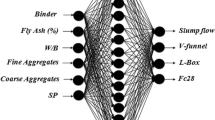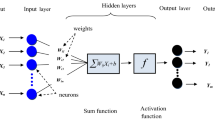Abstract
An experimental study was conducted to investigate the effects of using binary, ternary, and quaternary cementitious blends of portland cement (PC), fly ash (FA), ground granulated blast furnace slag (GBS), silica fume (SF), and metakaolin (MK) on initial and final setting times of self-compacting concretes (SCCs). For this purpose, a total of 65 SCC mixtures were prepared at two different water binder ratios. Furthermore, based on the experimental results, neural network (NN) model-based explicit formulations were developed to predict the initial and final setting times of SCCs in terms of the amount of concrete constituents, namely mixing water, PC, FA, GBS, SF, MK, fine (fa) and coarse (ca) aggregates, and superplasticizer (SP). The test results have revealed that the mineral admixtures were very effective on the initial and final setting times of SCCs. Besides, it was found that the model developed by using NN seemed to have a high prediction capability of initial and final setting times of SCCs.




Similar content being viewed by others
References
Domone PL (2007) A review of the hardened mechanical properties of self-compacting concrete. Cem Concr Compos 29(1):1–12
Okamura H (1997) Self-compacting high performance concrete. Concr Int 19(7):50–54
Okamura H, Maekawa K, Ozawa K (1993) High performance concrete. Gihoudou Publication, Tokyo (in Japanese)
Brooks JJ, Johari MAM, Mazloom M (2000) Effect of admixtures on the setting times of high-strength concrete. Cem Concr Compos 27:293–301
Stefanou GD, Larsinos CH (1981) Influence of mixing water on the setting time of concrete. Int J Cem Compos Lightweight Concr 3:45–48
Pinto RCA, Hover KC (1999) Application of maturity approach to setting times. ACI Mater J 96(6):686–691
Eren O, Brooks JJ, Celik T (1995) Setting of fly ash and slag-cement concretes as affected by curing temperature. Cem Concr Aggreg 17:11–17
Naik TR, Singh SS (1997) Influence of fly ash on the setting and hardening characteristics of concrete systems. ACI Mater J 94(5):355–360
Naik TR, Ramme BW (1990) Effects of high-lime fly ash on water demand, time of set, and compressive strength of concrete. ACI Mater J 87(6):619–626
De Almeida IR, Gonvalces AF (1990) Properties of freshly mixed high-strength concrete. In: Wierig H-J (ed) Proceedings of the RILEM colloquium on properties of fresh concrete, Honover, 1990
Ji T, Lin T, Lin X (2006) A concrete mix proportion design algorithm based on artificial neural networks. Cem Concr Res 36:1399–1408
Yeh IC (2007) Modeling slump flow of concrete using second-order regressions and artificial neural networks. Cem Concr Compos (in press). doi:10.1016/j.cemconcomp.2007.02.001
Nehdi M, El Chabib H, El Naggar MH (2001) Predicting performance of self-compacting concrete mixtures using artificial neural networks. ACI Mater J 98(5):394–401
Öztaş A, Pala M, Özbay E, Kanca E, Çaglar AN, Bhatti MA (2006) Predicting the compressive strength and slump of high strength concrete using neural network. Constr Build Mater 20:769–775
ASTM C 403/403M-99 (1999) Standard test methods for time of setting of concrete mixtures by penetration resistance, Annual book of ASTM standards, 04.02. Concrete and Concrete Aggregates, pp 1–6
Khayat KH, Bickley J, Lessard M (2000) Performance of self-consolidating concrete for casting basement and foundation walls. ACI Mater J 97(3):374–380
Alshamsi AM, Sabouni AR, Bushlaibi AH (1993) Influence of set-retarding superplasticizers and microsilica on the setting times of pastes at various temperature. Cem Concr Res 23:592–598
Alexhander I, Morton H (1993) Neurons and symbols: the staff that mind is made of. Chapman and Hall, London
Arbib MA (1995) Handbook of brain theory and NN. MIT Press, MA, USA
Anderson JA (1995) An introduction to neural networks. A bradford book. MIT Press, Cambridge, MA, USA
Akkurt S, Ozdemir S, Tayfur G, Akyol B (2003) The use of GA-ANNs in the modeling of compressive strength of cement mortar. Cem Concr Res 33(7):973–979
Mukherjee A, Biswas SN (1997) Artificial neural networks in prediction of mechanical behavior of concrete at high temperature. Nucl Eng Des 178(1):1–11
Topcu IB, Sarıdemir M (2007) Prediction of rubberized concrete properties using artificial neural network and fuzzy logic. Constr Build Mater (in press). doi:10.1016/j.concuildmat.2006.11.007
Baykasoglu A, Dereli T, Tanıs S (2004) Prediction of cement strength using soft computing techniques. Cem Concr Res 34:2083–2090
Uchimura S, Hamamoto Y, Tomita S (1995) Effects of the sample size in artificial neural network classifier design. IEEE 3:2126–2129
Acknowledgements
Authors would like to acknowledge the supports of Gaziantep University- Coordination office of Scientific Research Projects (GÜBAP) to carry out the present study. Moreover, the assistances of Mr. Mustafa Şeker, Mr. Serkan Taşatan, and Mr. Bekir Çeviksever during the experimental phase of the study are gratefully acknowledged.
Author information
Authors and Affiliations
Corresponding author
Rights and permissions
About this article
Cite this article
Güneyisi, E., Gesoglu, M. & Özbay, E. Evaluating and forecasting the initial and final setting times of self-compacting concretes containing mineral admixtures by neural network. Mater Struct 42, 469–484 (2009). https://doi.org/10.1617/s11527-008-9395-5
Received:
Accepted:
Published:
Issue Date:
DOI: https://doi.org/10.1617/s11527-008-9395-5




